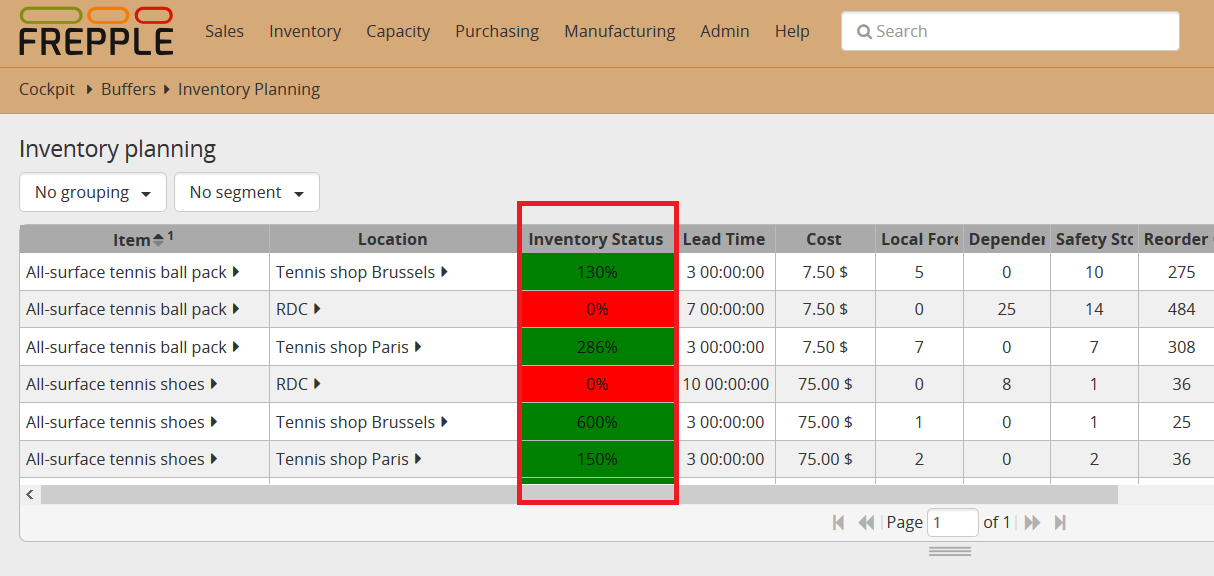Inventory status
Inventory status is only available on the enterprise edition of frePPLe.
Inventory status is a calculated field that helps planners identify the urgency of a manufacturing/distribution/purchase order and that also gives indication of the level of stock for a given buffer.
Before going further into details, we need first to make a distinction in the supply chain model between protected buffers (aka decoupling points, these are buffers for which an inventory policy has been defined) and unprotected buffers. For protected buffers, the inventory status will be expressed as a percentage.
Inventory status in the Inventory Planning screen
In the inventory planning screen, the inventory status is visible on the top pane:

On this screen, the inventory status will always be a percentage as only protected buffers are displayed.
The percentage displayed compares the safety stock with the lowest of a) the current onhand stock and b) the projected stock level one lead time from now.
The definition of the lead time is given at the botton of this page.
The background color of the inventory status cells helps planners immediately identify buffers that require attention.
A red cell means that very little or no safety stock will remain in one lead time from now, a stock out is expected if no action is performed.
An orange/yellow cell should draw the planner’s attention as a significant part of the safety stock will be consumed in one lead time.
A green cell indicates that no action is immediately required on the buffer as enough safety stock will remain in one lead time.
Consider as an example a buffer that is replenished through distribution orders with a replenishment lead time of 7 days. If the safety stock of this buffer is 5 and the expected on hand in 7 days is equal to 2 then the inventory status is equal to 40% which corresponds to an orange background color.
The attribute tab of the inventory planning screen contains a widget giving explanations on the calculation:

Inventory status in the manufacturing/distribution/purchase orders screens
For the manufacturing/distribution/purchase orders screens, the same concept of background colors is used on the inventory status column to help the planner focus on the important manufacturing/distribution/purchase orders, the red ones are critical and require special attention while the green ones can wait.
Note that the value displayed in the inventory status column can be of 3 different types, it can be either a percentage, a delay (in days) or a blank cell:

A percentage is displayed if the MO/PO/DO replenishes a protected buffer. The inventory status of the protected buffer is displayed if the status of the MO/PO/DO is proposed. If the status is confirmed the percentage displayed corresponds to current on hand divided by safety stock. If the replenished buffer is not a protected buffer, then the least inventory status of the first protected buffers found on each downstream path is displayed. If no protected buffer is found on the downstream supply path, a delay is displayed.
A delay in days that is equal to the delay column of the table. It represents the difference between the receipt/end date of the DO/PO/MO and the latest date to receive/manufacture the item to make sure that all demands fed by this DO/PO/MO are on time.
A blank cell means that the inventory status is not computed. Typically this happens if the DO/PO/MO is beyond the lead time and a proposed DO/PO/MO for which the inventory status has been computed exists. This DO/PO/MO can be ignored as it is beyond the lead time.
Definition of lead time
The lead time used by the inventory status corresponds to the longest unprotected lead time found while exploring all upstream paths of a buffer.
FrePPLe’s implementation fully complies with the DDMRP concept of decoupled lead time.
For a given buffer:
- If the item is purchased from a supplier then the lead time is the supplier lead time.
- If the item is replenished through distribution orders, then the lead time is the transport lead time if the source buffer is protected.
- If the source buffer is not protected, then the lead time is the transport lead time plus the source buffer’s lead time.
- If the item is replenished through manufacturing orders, then the lead time is the manufacturing lead time if the consumed buffers are all protected.Otherwise the lead time will be equal to the manufacturing lead time plus the greatest lead time of all unprotected buffers.
